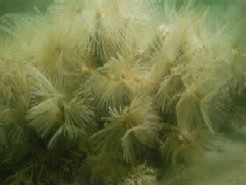Reefs may have a rocky substrate (non-biogenic reefs) or be constructed by animals (biogenic reefs).
Non-biogenic reefs
In Ireland, non-biogenic reefs are found both intertidally and subtidally, from sheltered waters through areas moderately exposed to swell and wave action, to waters exposed to the full forces of Atlantic waves. Across this range reefs may be subjected to strong tidal currents. The structure of reefs varies from bedrock to boulders or cobbles while topography ranges from horizontal to vertical and the reefs may have numerous ledges and crevices. The geology includes limestone, shale, granite, schists and gneiss. All of these factors affect both the species present and their abundance. Their depth range is unknown but is likely to extend below 1200 m. Typical species change with increasing depth. Brown fucoid algae generally dominate the intertidal down to shallow subtidal areas. The latter are characterised by kelp species, frequently with an understorey of red foliose algae. Below the kelp and down to about 30 m, red algae characterise the substratum with very few brown algae. Below this, the habitat is characterised by faunal species; very few foliose or filamentous red algae occur although encrusting red algae may be common.
Biogenic reefs
The shallowest reefs are intertidal, including honeycomb reefs made by the polychaete worm Sabellaria alveolata and reefs made by the mussel Mytilus edulis. Sublittoral biogenic reefs in Ireland include:
1) Serpula Reefs
The polychaete worm Serpula vermicularis secretes a calcareous tube and is common as a solitary worm. However under sheltered conditions with a very gentle tidal stream the worms aggregate and form structures which may be up to 1 m in height and about 2 m in diameter. The spaces between the worm tubes are inhabited by a wide variety of species such as brittlestars and crabs but will vary from place to place. In Ireland such reefs have a very limited distribution and are only know from three localities where they occur from depths of 2–19 m.
2) Sabellaria Reefs
These are constructed by the polychaete worm Sabellaria spinulosa, except at Wicklow Head where the subtidal reef is recorded as being constructed by S. alveolata. The reefs are constructed of sand grains by the worm and form a substrate for many other species that would not normally be present in the area in the absence of the reefs. The reefs can be up to a metre in thickness.
3) Bivalve Reefs
Mussels occur intertidally on rocky shores, particularly on exposed coastlines where they occur in large patches and can be a characterising species but generally remain small. Mussels also form reefs on sediment where there is some hard substratum for attachment. They may also occur in sheltered, tide-swept areas where they reach a much larger size. Native Oyster Ostrea edulis beds, when undisturbed, also form reef-like structures.
4) Cold Water Coral Reefs
Cold water coral reefs are from 200–1600 m, where the water temperature is 4–8ºC and the salinity is 32–36%. Coral reefs found to date are generally associated with carbonate mounds, features that rise up to 300-500 m above the sea floor. These are found close to the continental shelf slope and on the Rockall Bank. Corals are also recorded on the Hatton Bank. The typical reef forming species are Lophelia pertusa and Madrepora oculata. They create a complex 3-dimensional structure and provide a habitat for many other species which live both on live and dead coral or in the spaces between the coral branches.
|
Sabellaria Reef (Photo: MERC) |
Click on the following link for more information:
|

